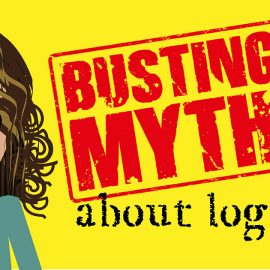The Difference Between a Logo and an Icon
The terms like “logo” and “icon” are often used interchangeably, leading to confusion. What’s the difference between them? While they may seem similar at first glance, logos and icons serve distinct purposes and have unique characteristics.
Understanding these differences is crucial for anyone involved in branding, design or marketing. So, let’s explore what sets logos and icons apart.
What is a logo?
A logo is a graphic mark, emblem or symbol used to identify a company, organisation, product or brand. It is a critical component of a brand’s identity and is often the first thing people associate with a brand.
A well-designed logo communicates the essence of the brand and can evoke emotions, build trust and establish recognition.
Characteristics of a logo
- Uniqueness: A logo should be unique and distinguishable from other logos to avoid confusion and ensure that the brand stands out.
- Versatility: A good logo should be versatile enough to look great on various mediums and platforms, from business cards to billboards.
- Timelessness: A logo should be designed to endure and remain relevant over time, avoiding trends that may quickly become outdated.
- Relevance: A logo should reflect the brand’s identity, values and industry. It should resonate with the target audience.
What is an icon?
An icon is a simplified graphic that represents an idea, concept, operation or object. Icons are widely used in user interfaces (UIs) of digital products, such as websites and mobile apps, to facilitate navigation and enhance user experience.
Icons can also be found in various other contexts, such as signage, maps and instruction manuals.
Characteristics of an icon
- Simplicity: Icons are designed to be simple and easily recognisable, even at small sizes. They often use minimal details to convey meaning quickly.
- Clarity: Icons should be clear and unambiguous, making it easy for users to understand their purpose at a glance.
- Consistency: Icons used within the same system or application should maintain a consistent style to create a cohesive user experience.
- Functionality: Icons often have a functional role, such as representing a button, link or action within an interface.
Key differences between logos and icons
1. Purpose
Logos are primarily used for branding and identification. They represent the entire brand and its values.
Icons are used for functionality and navigation within a specific context, often to represent actions, objects or ideas.
2. Design complexity
Logos can be more complex and detailed, incorporating various elements like typography, colours and intricate designs.
Icons are typically simple and minimalistic to ensure quick recognition and clarity, especially at smaller sizes.
3. Application
Logos appear on marketing materials, products, packaging, websites and anywhere the brand needs to be identified.
Icons are used within user interfaces, instruction manuals, signage and other contexts where they serve a functional purpose.
4. Recognition
Logos are designed to create a lasting impression and are closely tied to the brand’s identity and reputation.
Icons are meant to be instantly recognisable and understood, often without the need for text or additional explanation.
While logos and icons both play vital roles in design, understanding their differences is essential for effective communication and branding. A logo encapsulates the identity and values of a brand, aiming to create a strong and memorable association.
On the other hand, an icon serves a more functional role, aiding in navigation and user interaction through its simplicity and clarity.
Can an icon be used as a logo?
The answer is yes, but with certain considerations and caveats. Let’s look into the scenarios where an icon can serve as a logo and the factors that make this effective.
When can an icon be used as a logo?
1. Simplicity and recognition
An icon can function as a logo if it is simple yet distinctive enough to be easily recognised. Simplicity aids in memorability and ensures the design remains clear across various sizes and applications.
2. Strong brand identity
For an icon to work as a logo, it must encapsulate the brand’s identity and values. This often means the icon should carry enough meaning and relevance to represent the brand on its own.
3. Versatility
Icons used as logos must be versatile. They should look good on different mediums, from digital screens to physical products. This requires a design that maintains its integrity and recognisability across various contexts.
Examples of icons used as logos
Several well-known brands have successfully used icons as logos.
- Apple: The iconic apple with a bite taken out is a prime example. It’s simple, instantly recognisable and encapsulates the brand’s identity.
- Nike: The swoosh is another classic example. It’s minimalistic yet powerful enough to stand alone as the brand’s logo.
Factors to consider
1. Brand recognition
Established brands with strong recognition can more easily use icons as logos. Newer or lesser-known brands might struggle with an icon-only approach, as it may lack the necessary brand recognition.
2. Complexity of message
If a brand’s message is complex or requires more explanation, an icon alone might not suffice. In such cases, combining the icon with a wordmark or other elements can enhance clarity and communication.
3. Industry standards
Certain industries may have norms or standards that influence logo design. For example, tech companies often favour simple, modern icons, while more traditional industries might prefer more elaborate designs.
While an icon can be used as a logo, it requires careful consideration of factors such as simplicity, brand identity and recognisability. Icons that succeed as logos are typically those that are memorable, versatile and capable of conveying the brand’s essence in a minimalistic form. For some brands, an icon can serve as a powerful and effective logo, making a lasting impression on audiences worldwide.
Conclusion
By recognising the distinct purposes and characteristics of logos and icons, designers and marketers can better utilise these tools to create impactful and effective visual communication. Whether crafting a timeless logo or designing a clear and functional icon, each element plays a crucial part in the broader landscape of design and branding.
A good logo should reflect the spirit of your brand. Need a professional looking logo for your business?



